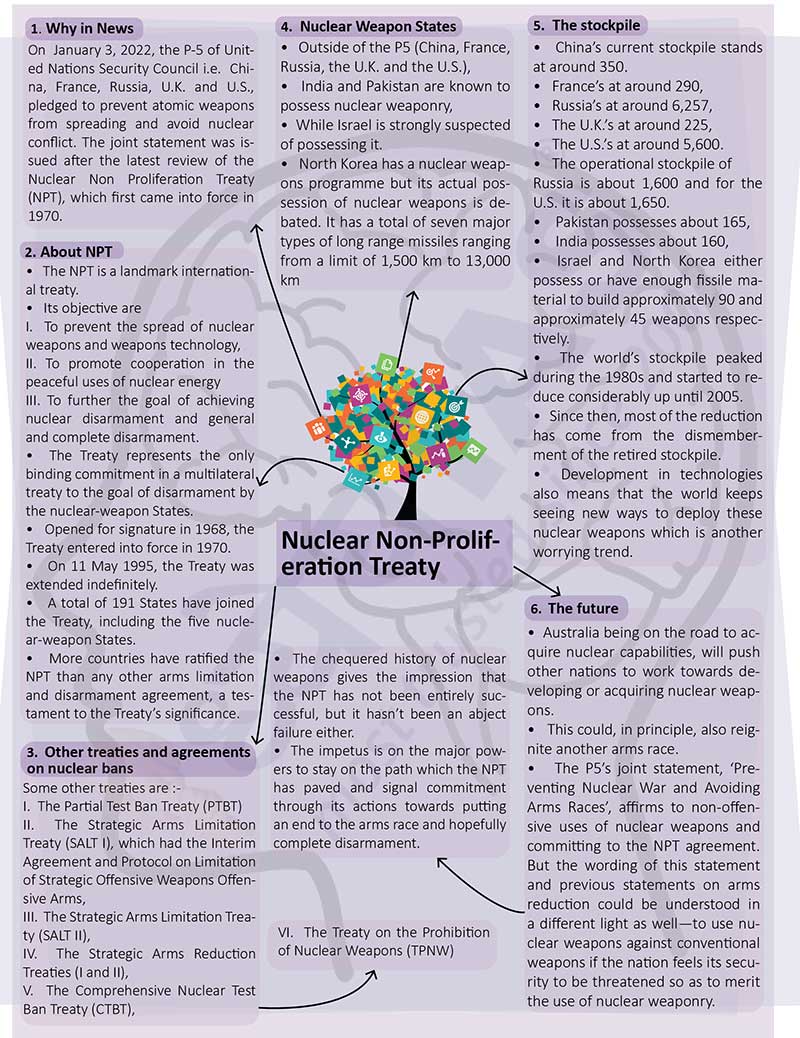Why in News?
- On January 3, 2022, the P-5 of United Nations Security Council i.e. China, France, Russia, U.K. and U.S., pledged to prevent atomic weapons from spreading and avoid nuclear conflict. The joint statement was issued after the latest review of the Nuclear Non Proliferation Treaty (NPT), which first came into force in 1970.
About NPT
- The NPT is a landmark international treaty.
- Its objective are
- To prevent the spread of nuclear weapons and weapons technology,
- To promote cooperation in the peaceful uses of nuclear energy
- To further the goal of achieving nuclear disarmament and general and complete disarmament.
- The Treaty represents the only binding commitment in a multilateral treaty to the goal of disarmament by the nuclear-weapon States.
- Opened for signature in 1968, the Treaty entered into force in 1970.
- On 11 May 1995, the Treaty was extended indefinitely.
- A total of 191 States have joined the Treaty, including the five nuclear- weapon States.
- More countries have ratified the NPT than any other arms limitation and disarmament agreement, a testament to the Treaty’s significance.
Other treaties and agreements on nuclear bans
Some other treaties are :-
- The Partial Test Ban Treaty (PTBT)
- The Strategic Arms Limitation Treaty (SALT I), which had the Interim Agreement and Protocol on Limitation of Strategic Offensive Weapons Offensive Arms,
- The Strategic Arms Limitation Treaty (SALT II),
- The Strategic Arms Reduction Treaties (I and II),
- The Comprehensive Nuclear Test Ban Treaty (CTBT),
- The Treaty on the Prohibition of Nuclear Weapons (TPNW)
Nuclear Weapon States
- Outside of the P5 (China, France, Russia, the U.K. and the U.S.),
- India and Pakistan are known to possess nuclear weaponry,
- While Israel is strongly suspected of possessing it.
- North Korea has a nuclear weapons programme but its actual possession of nuclear weapons is debated. It has a total of seven major types of long range missiles ranging from a limit of 1,500 km to 13,000 km
The stockpile
- China’s current stockpile stands at around 350.
- France’s at around 290,
- Russia’s at around 6,257,
- The U.K.’s at around 225,
- The U.S.’s at around 5,600.
- The operational stockpile of Russia is about 1,600 and for the U.S. it is about 1,650.
- Pakistan possesses about 165,
- India possesses about 160,
- Israel and North Korea either possess or have enough fissile material to build approximately 90 and approximately 45 weapons respectively.
- The world’s stockpile peaked during the 1980s and started to reduce considerably up until 2005.
- Since then, most of the reduction has come from the dismemberment of the retired stockpile.
- Development in technologies also means that the world keeps seeing new ways to deploy these nuclear weapons which is another worrying trend.
The future
- Australia being on the road to acquire nuclear capabilities, will push other nations to work towards developing or acquiring nuclear weapons.
- This could, in principle, also reignite another arms race.
- The P5’s joint statement, ‘Preventing Nuclear War and Avoiding Arms Races’, affirms to non-offensive uses of nuclear weapons and committing to the NPT agreement. But the wording of this statement and previous statements on arms reduction could be understood in a different light as well—to use nuclear weapons against conventional weapons if the nation feels its security to be threatened so as to merit the use of nuclear weaponry.
- The chequered history of nuclear weapons gives the impression that the NPT has not been entirely successful, but it hasn’t been an abject failure either.
- The impetus is on the major powers to stay on the path which the NPT has paved and signal commitment through its actions towards putting an end to the arms race and hopefully complete disarmament.
























